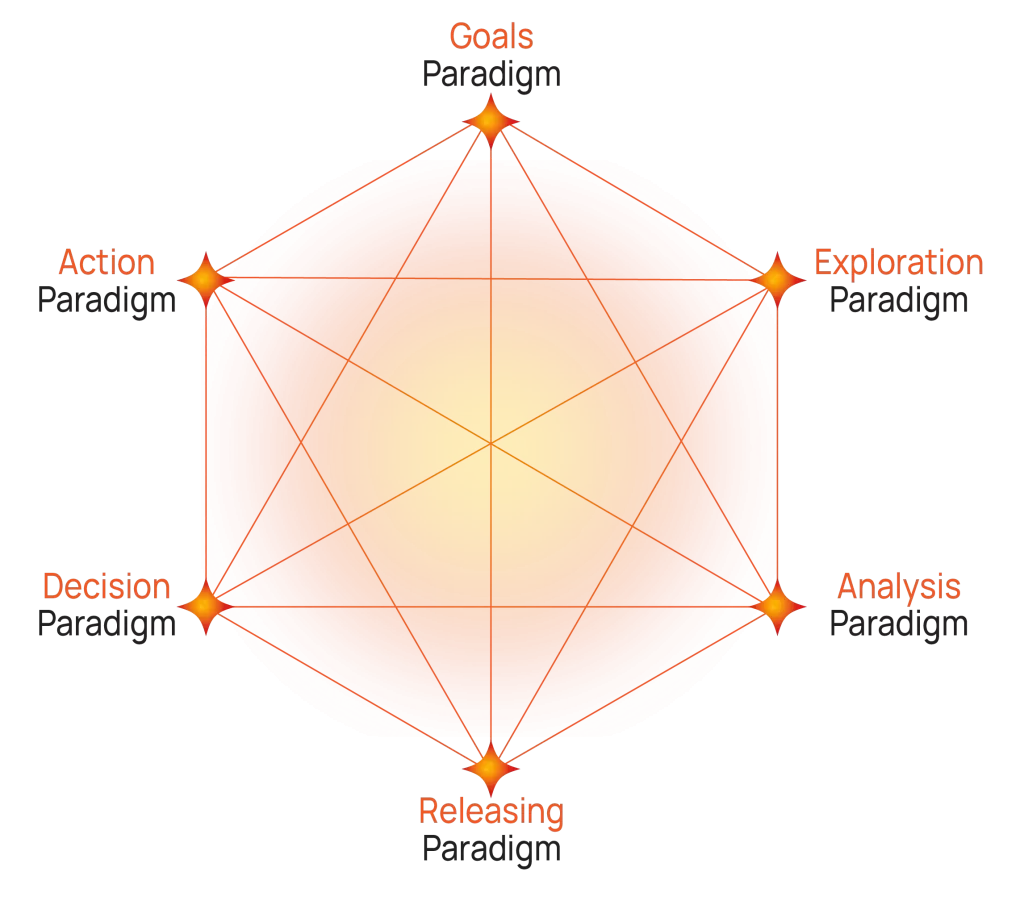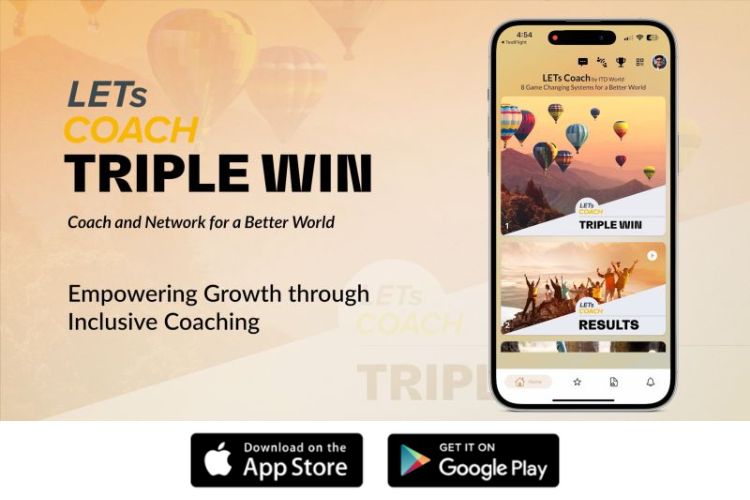Situational Coaching Model

The Situational Coaching Model (SCM) is a versatile framework by #1 Strategic Innovation Coach and ITD World CEO Dr Peter Chee. This coaching framework equips coaches to adapt their approach based on the unique needs and the situation coachee find themselves in. The SCM contains six core paradigms for coaches to operationalize. These six are: Goals, Exploration, Analysis, Releasing, Decision, and Action. By understanding and applying the six key paradigms, coaches are enable to coach people for results.
The measure of intelligence is the ability to change – Albert Einstein, Nobel Prize Winning Physicist
Goals Paradigm
The Goals Paradigm can be a good starting point for any coaching engagement. Here, coaches help the coachee articulate what they want to achieve, ensuring clarity and alignment between long-term objectives and short-term actions. This paradigm emphasizes the importance of setting meaningful goals and regularly revisiting them to ensure relevance.
Scenario: Sarah, a marketing manager, wants to secure a promotion to director within 18 months.
Coaching Approach: The coach begins by asking Sarah what success looks like for her and helps her articulate her overarching goal. Together, they identify subgoals, such as enhancing leadership skills, improving strategic planning abilities, and building relationships with key stakeholders. The coach ensures Sarah’s goals are SMARTEST (Specific, Measurable, Achievable, Relevant, Time-bound, Engaging, Satisfying, Team-based). During follow-up sessions, they review Sarah’s progress, adjusting goals as needed. For example, when Sarah is assigned a high-profile project, they incorporate strategies to leverage this as a leadership showcase.
A good goal is like strenuous exercise, it makes you stretch – Mary Kay Ash, founder of Mary Kay Cosmetics
Exploration Paradigm
The Exploration Paradigm helps to broaden the coachee’s perspective and fosters creative thinking. Coaches act as thinking partners, encouraging out-of-the-box ideas and approaches. It is here that coaches also challenge assumptions, identify roadblocks, and unlock innovative solutions.
Scenario: John, a startup founder, struggles to grow his business in a competitive market.
Coaching Approach: The coach facilitates brainstorming sessions, encouraging John to explore alternative revenue streams and untapped markets. Through probing questions, John considers introducing a subscription model for his product, an idea he had previously overlooked. The coach also helps John examine case studies of similar businesses, drawing insights that refine his strategy. By fostering an environment of open-mindedness, the coach enables John to see opportunities he may not have recognized initially.
This is one small step for a man, one giant leap for mankind – Neil Armstrong, first man on the moon
Analysis Paradigm
After generating ideas, the Analysis Paradigm helps the coachee prioritize options and make informed decisions. This phase focuses on evaluating possibilities to identify the most impactful choices that brings them closer to their goals. If the coachee already has ideas, there is nothing to stop the coach from jumping into this paradigm first. The situational coaching model, or SCM, is flexible in that the coach can start the coaching conversation from any of the six key paradigms, depending on the situation.
Scenario: Maria, an HR executive, needs to resolve low employee engagement in her organization.
Coaching Approach: The coach assists Maria in analyzing employee survey data to identify key issues, such as lack of recognition and limited career development opportunities. By dissecting potential solutions, Maria evaluates the feasibility and impact of initiatives like a rewards program and mentorship opportunities. Together, they assess the alignment of these solutions with the organization’s culture and goals, ultimately selecting the most effective approach. This structured analysis ensures Maria’s efforts yield meaningful result
Get the habit of analysis, analysis will enable, in time, synthesis to become your habit of mind – Frank Lloyd Wright, award winning architect
Releasing Paradigm
If the coachee seems stressed out at the start of the session, there is no reason not to begin the coaching conversation with the Releasing Paradigm. Here, the coach addresses emotional barriers that hinder progress. Coaches provide a safe space for coachees to express and process their feelings, enabling them to move forward with clarity and resilience.
Scenario: Ahmed, a project manager, feels overwhelmed after a critical project failure.
Coaching Approach: The coach listens empathetically as Ahmed shares his frustrations, allowing him to release pent-up emotions. By using reflective questioning, Ahmed identifies the root of his feelings and reframes the experience as an opportunity for growth. For instance, Ahmed realizes that a miscommunication issue led to the failure, and he begins focusing on improving team communication. This emotional release lightens Ahmed’s psychological burden and restores his confidence.
Who imprisoned me here? Who keeps me here? Who can release me? Who’s constraining and controlling my life … except me? – Alan Moore, British author
Decision Paradigm
This is the moment of truth. The time when the coachee now has to fix their effort on a course of action. Here is where the coach enters the Decision Paradigm to supports coachees in making thoughtful choices without undue pressure. Coaches help coachees evaluate options and commit to decisions aligned with their goals and values.
Scenario: Priya, a software engineer, is deciding between two job offers.
Coaching Approach: The coach guides Priya through a structured decision-making process, encouraging her to list the pros and cons of each offer. By exploring her career aspirations, work-life balance preferences, and long-term goals, Priya gains clarity on her priorities. Ultimately, she chooses the role that offers better alignment with her professional and personal values, feeling confident in her decision. The coach ensures that Priya reflects deeply on potential outcomes, avoiding hasty decisions while ensuring her choice aligns with her vision for the future.
Two basic values, solidarity and autonomy, serve as helpful prompters in any decision-making process – György Konrád, Hungarian sociologist
Action Paradigm
The Action Paradigm transforms plans into reality. Coaches help coachees create actionable steps, establish accountability with accountability partners, and build momentum for achieving their goals.
Scenario: Daniel, a sales professional, wants to double his client base within a year.
Coaching Approach: The coach collaborates with Daniel to outline a detailed action plan, including attending industry events, improving follow-up techniques, and leveraging social media for networking. To maintain momentum, they set weekly check-ins to review progress and address obstacles. Additionally, the coach helps Daniel identify an accountability partner who provides ongoing support. This structured approach ensures Daniel stays on track and achieves measurable results.
If you spend too much time thinking about a thing, you’ll never get it done – Bruce Lee, Chinese film star and martial artist
Flexibility is the Key for Success
The Situational Coaching Model (SCM) is a powerful framework that guides coaches toward coaching results. By mastering each paradigm and remaining flexible, coaches can address diverse challenges and inspire greatness in others. Whether it’s setting goals, exploring possibilities, analyzing options, releasing emotional blocks, making decisions, or taking action, the SCM provides a structured yet adaptable approach to transformative coaching.

The SCM’s strength lies in its flexibility. Coaches must adapt their approach based on the coachee’s needs and progress. By weaving seamlessly through the paradigms, great coaches empower individuals to unlock their potential and achieve extraordinary outcomes. Take a deep dive about the Situational Coaching Model in the book Coaching for Breakthrough Success authored by Dr Peter with World #1 Success Coach Jack Canfield. The book gives you a holistic deep dive into the successful operation of each paradigm. Pick up your copy on Amazon today.

